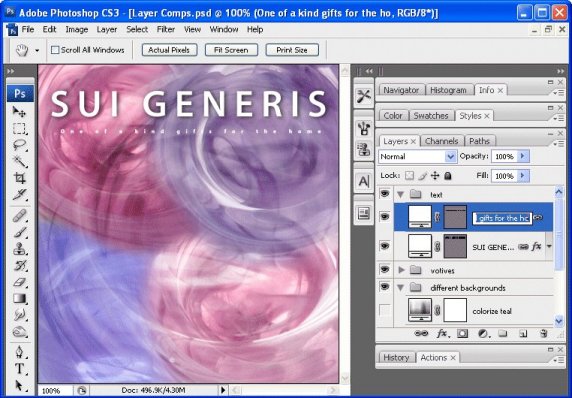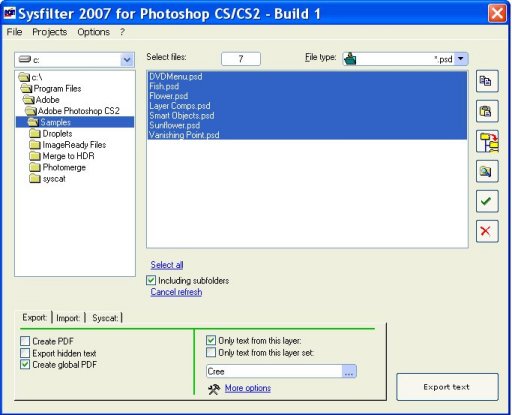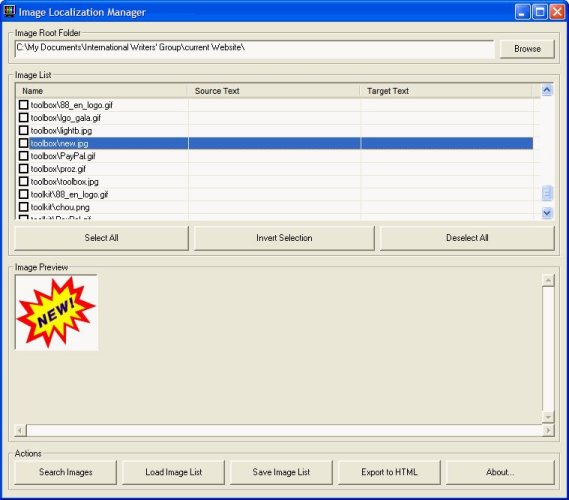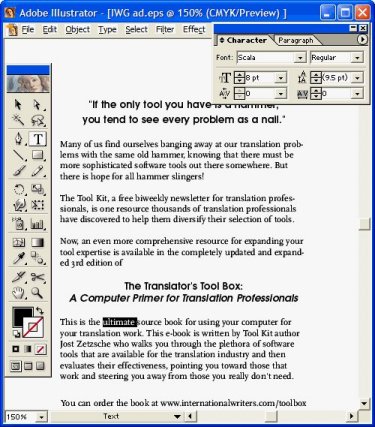|
Front Page
|
| |
|
|
Getting Graphicby Jost Zetzsche | |
|
Getting Graphic
First of all, short of recreating these kinds of graphics from scratch, you will need to get your hands on the "source files." (Yes, I know that clients hate to be asked for those, but it usually helps to mention that otherwise they will have to pay ten times as much.) Most .jpg-, .gif-, .bmp-, or .tiff-like files were created in a layered file that includes one (or several) layers with real, editable text. Since they were most likely created in Adobe Photoshop, they will have a .psd extension and can be opened in, well, Adobe Photoshop.
Image file opened in Photoshop with active text layer
The nice thing is that Adobe offers a low-priced version of its program that is more than adequate for translating the text layers that need to be translated. Or you can also use GIMP, a powerful open-source image editor that allows you to work with .psd files, though it may not be particularly user-friendly (and it might also mess up some of the text layers—but at least you can access the different layers, delete the text layer, and recreate a new one). This all may not be good enough, though. Especially if you have a large number of graphics and/or a translation memory database that contains much of the translation embedded within the graphics, you will not want to perform the translation "manually." In this case you can use a number of tools, including those from ECM Engineering or Transmissions, that allow for the extraction of text from .psd files into RTF or XML formats. These formats can be processed in TEnTs (translation environment tools, such as Trados, Déjà Vu, Across, and MemoQ) and afterward re-inserted.
Processing Photoshop files in Sysfilter
More often than not, we don't have access to the source files and have to go through frustrating re-creation or manipulation processes with the graphics. To ease at least some of that (translator) pain, there are a number of management applications for images, such as the open-source tool Image Localization Manager. It's a nifty little tool that allows you to quickly browse folder and subfolders for graphics that are displayed nicely within the tool, determine which contain localizable content, create a list of those image files, and (manually) enter the source text. This can then be exported into a file that you can translate in something like Excel or, if you want to view the graphic as you translate, in Image Localization Manager. Of course, when that's done, the translated text and the graphics have to be passed on to the desktop publisher—but as translators, that's not our worry!
Assessing which graphics need translation in ILM
The image files we have discussed so far are all pixel-based graphics. Another kind of graphic that is often used, especially in manuals, is vector-based graphics. You can recognize them by their typical extensions, .eps, .ai, or .cdr. They are very different from pixel-based graphics because they are formed by mathematical formulas rather than by simple dots. So rather than displaying a wheel by arranging a lot of pixels in a circle, a vector-based graphic would calculate it with some kind of pi-based formula. In contrast to pixel-based graphics, it is possible to translate most vector-based files directly in applications like Adobe Illustrator or Corel Draw.
View of an .eps graphic file in Adobe Illustrator
If you would like to either batch process the files or use your translation memory, there are two different options. The above-mentioned ECM Engineering and Transmissions both offer products for Illustrator and Draw (only ECM Engineering) files that pre-process the files for use in computer-assisted translation tools similarly to the way they process .psd files. The second option is to save the vector-based files into the XML-based SVG format, which is supported by a number of TEnTs, including Heartsome, Swordfish, Trados, and some versions of Star Transit. To save these files as SVG files, of course, you need either Illustrator or CorelDraw. And did I mention that they are not cheap? So, like I said earlier, the decision whether or not to "get graphic" really comes down to one's marketing philosophy. I for one have decided to stay with the things I know I can do well—and leave the graphics work to the desktop publishers. |
|
|
|



